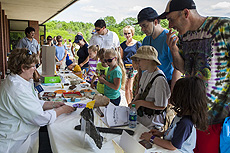Bison, birds and bugs at Fermilab's Family Outdoor Fair on June 14
 |
The whole family can enjoy the activities at the June 14 Family Outdoor Fair. Photo: Cindy Arnold |
What could be better than spending a fun-filled day outdoors and learning about natural science at the same time?
For the eighth year in a row, Fermi National Accelerator Laboratory is inviting families and scout troops to attend the Family Outdoor Fair on Sunday, June 14, from 1-4 p.m. The fair takes place outside the Lederman Science Center and highlights the plant and animal life found on the 6,800-acre Fermilab site in Batavia.
More than a dozen outdoor activities are planned for the fair, including a prairie scavenger hunt, a visit with Fermilab's herd of bison, and a performance by "Earth Singer" Dave Orleans. Kids can test whether they can run as fast as a bison, can sweep for insects and other critters, and thanks to the Naperville Astronomical Association, safely get a long look at the sun.
Once again, the Northern Illinois Raptor Rehabilitation and Education Center, along with local raptor trainers, will be on hand with live hawks, falcons and owls, as well as a collection of bird bones, feathers and hunting gear for children to enjoy.
"We want kids to come away with an appreciation of nature," said Sue Sheehan of the Fermilab Education Office. "There's so much to see. We want to show kids and parents that science is everywhere, even in their own back yards."
Read more
|